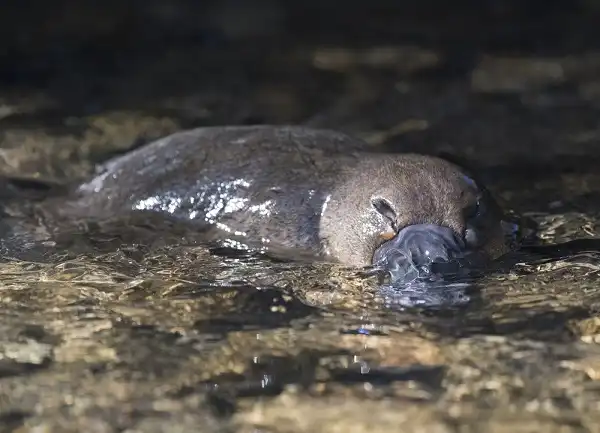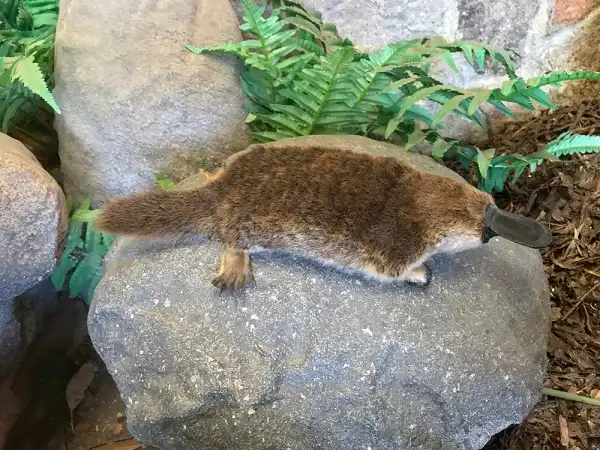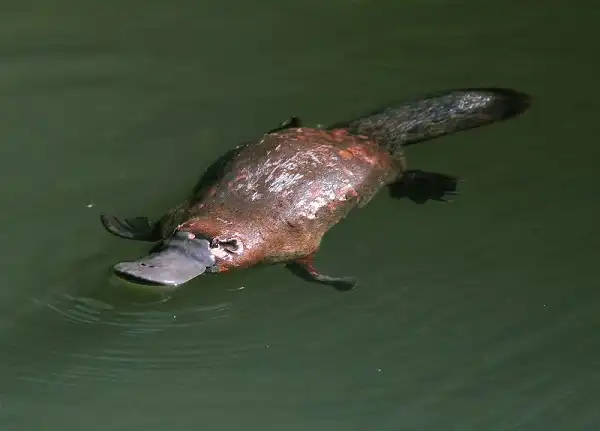Have you ever seen a platypus in real life? These incredible creatures are one of nature’s most unique and unusual creations. With their duck-like bills, beaver tail, webbed feet, and otter-like bodies, the platypus is an animal unlike any other. But what may be more remarkable than its strange physical characteristics is the mysterious behavior that has captivated animal lovers for centuries. In this blog post, we’ll explore the biology and behavior of these animals to get a better understanding of how they live underwater and on land alike!

Platypus Description
The platypus (Ornithorhynchus anatinus) is a unique and remarkable creature. It has a duck-like bill, beaver-like tail, webbed feet, and an otter-like body. It is one of the few mammals that lays eggs rather than giving birth to live young. The platypus also has venomous spurs on its hind legs which it uses to defend itself against potential predators. They have dense fur which helps insulate them from cold temperatures and keep them dry when swimming underwater. The fur is typically dark brown or black with lighter patches on the muzzle, throat, chest, and lower belly.
Platypus Habitat
Platypuses inhabit the freshwater rivers and streams of eastern Australia. Typically, they prefer slow-moving, shallow waters with plenty of aquatic vegetation, as this provides them with a safe refuge and plenty of food sources. These habitats often consist of dense tussocks, reeds, overhanging trees, and logs which form a natural shelter for the platypus. They are also found in larger bodies of water such as dams and lakes. These individuals will dig burrows on the banks of larger bodies of water so that they can access open water when needed. When it is too cold to stay submerged in these areas for long periods of time, platypuses will migrate to deeper waters where temperatures remain relatively consistent throughout the year.
Platypuses can survive in a wide range of different habitats provided there is an adequate food source available. This includes both slow-moving rivers and swift-running creeks, as well as smaller ponds and lakes. In addition to their preferred aquatic habitat, platypuses also have adapted to living partially on land. They create burrows in moist soils near bodies of water which can provide protection from predators as well as providing them with warmer temperatures during cold winter months when temperatures drop significantly in their preferred habitat.
Platypus Diet
The platypus diet consists mainly of aquatic invertebrates such as crustaceans, insect larvae, shrimp, small fish, worms, yabbies, and other aquatic organisms. They feed mainly at night by diving underwater and using their beaks to locate prey. Their highly specialized beak contains electroreceptors that help them sense the movement of their prey even in murky or muddy waters. Platypuses are also known to occasionally forage on land for insects or small mammals. Platypuses need a lot of energy due to their active lifestyle and therefore are able to consume large amounts of food each day – up to 20 percent of their body weight! This high caloric intake allows them to sustain both a fully aquatic and partially terrestrial lifestyle where they can build burrows while still spending enough time in the water to hunt and feed properly.

Platypus Size
The platypus is a medium-sized animal, typically measuring 12-20 inches in length and weighing anywhere from 2 to 5 pounds. They have a compact body with short and strong legs that allow them to move around both in and out of the water with ease. Their webbed feet help them swim more efficiently while their sharp claws make them excellent diggers for burrowing into the banks of rivers. The platypus has a thick coating of fur made up of 2 layers, an outer layer that is waterproof, and an inner layer that helps keep the animal warm even in very cold temperatures. The fur is typically dark brown or black with lighter patches on its muzzle, throat, chest, and lower belly. When fully grown, adult male platypuses can reach lengths of up to 24 inches while female platypuses typically measure no larger than 18 inches in length. As such, they are considered one of the smaller mammals found throughout eastern Australia. However, despite its size, its sharp claws and venomous spurs make it quite formidable when defending itself against predators.
Platypus Lifespan
The average lifespan of a platypus is roughly 10-14 years when living in the wild. This relatively short lifespan is due to the fact that they are a prey species, making them vulnerable to predators such as snakes, birds of prey, and foxes. They also may encounter dangerous water habitats such as dams and reservoirs which can cause drowning or overpopulation of their habitat. In captivity, platypuses can live longer than in the wild thanks to protection from predators and better access to food sources. The oldest recorded platypus lived for an astonishing 22 years in captivity! Overall, while the lifespan of a platypus may be relatively short when living in the wild, captive individuals have been known to live substantially longer due to consistent access to food sources as well as protection from predators. Furthermore, if given adequate care and support by adults during the early stages of life there is a chance that these remarkable creatures could extend their lives even further into adulthood.
Platypus Behavior
The platypus is a very active creature and has adapted behaviors that enable it to survive in both aquatic and terrestrial environments. On land, they use their sharp claws to dig burrows to shelter from predators as well as the elements. In water, they use their webbed feet to swim efficiently and can remain submerged for extended periods of time due to their dense fur trapping air bubbles which provide buoyancy. Platypuses are mainly nocturnal creatures, spending most of the day in their burrows or underwater foraging for food. When hunting, they utilize both a specialized beak that contains electroreceptors which help them sense movement from prey even in murky waters as well as a suction technique where they suck up mud and debris from the bottom in search of worms or larvae.

Platypus Speed
Platypus speed is a remarkable adaptation that allows them to quickly move both in and out of water. On land, they can reach speeds of up to 20 km/h (12 mph). In the water, their powerful webbed feet enable them to swim at speeds of up to 8 km/h (5 mph). This incredible speed helps them escape predators or locate food sources more efficiently. Their unique fur also plays an important role in platypus speed. The air bubbles trapped between the inner and outer layers of fur provide buoyancy when swimming, allowing them to move faster and with greater agility than some other species of aquatic mammals. Furthermore, this insulation also helps keep their body temperature regulated even in cold temperatures, meaning they are able to maintain their speed even when conditions are less than ideal.
Platypus Hunting
Platypus hunting is an essential part of their survival, allowing them to feed and protect themselves. They are highly adapted hunters capable of hunting on land and in water. When hunting on land, they use their sharp claws to dig burrows where they can hide from predators as well as store food for later consumption. In the water, they rely on their powerful webbed feet to swim quickly and efficiently while searching for food sources such as worms or larvae. Platypuses have specialized beaks that contain electroreceptors that help them detect movement from prey even in murky conditions. They also employ a suction technique where they suck up mud and debris from the bottom in search of edible organisms. When hunting underwater, platypuses can remain submerged for extended periods of time due to their dense fur trapping air bubbles which provide buoyancy and allow them greater agility when swimming. Their sharp claws also help provide extra grip on slippery surfaces both underwater and on land giving them an edge when tracking potential prey.
Platypus Reproduction
Platypus reproduction is a complex process that involves both males and females. Males typically reach sexual maturity at around 2 years of age while females reach maturity closer to three. During mating season, which usually occurs between late October and April, males will compete for mates using their venomous spurs. Mating usually takes place in water with the male embracing the female from behind while clasping her head with his feet. Once mating has taken place, the female will lay up to 3 eggs per breeding session which are then incubated for 10-12 days before hatching.
During this time, the female platypus will typically line her burrow with leaves and sticks to keep her eggs warm due to her inability to provide direct heat like other mammals. After hatching, adult platypuses provide protection until young platypuses can fend for themselves; this is especially important during temperature fluctuations as adult platypuses are able to regulate their own body temperatures more effectively than younger platypuses. Once they have grown stronger and mature enough, they will leave their parent’s care in search of food and shelter on their own.

Conclusion
The platypus is an incredibly unique species that has adapted a variety of behaviors and physical characteristics in order to effectively survive in both aquatic and terrestrial environments. They use their powerful webbed feet to swim quickly while hunting for food, their electroreceptive beaks to detect movement from the prey, and their sharp claws to help create burrows in which they can hide from predators.
Frequently Asked Question


